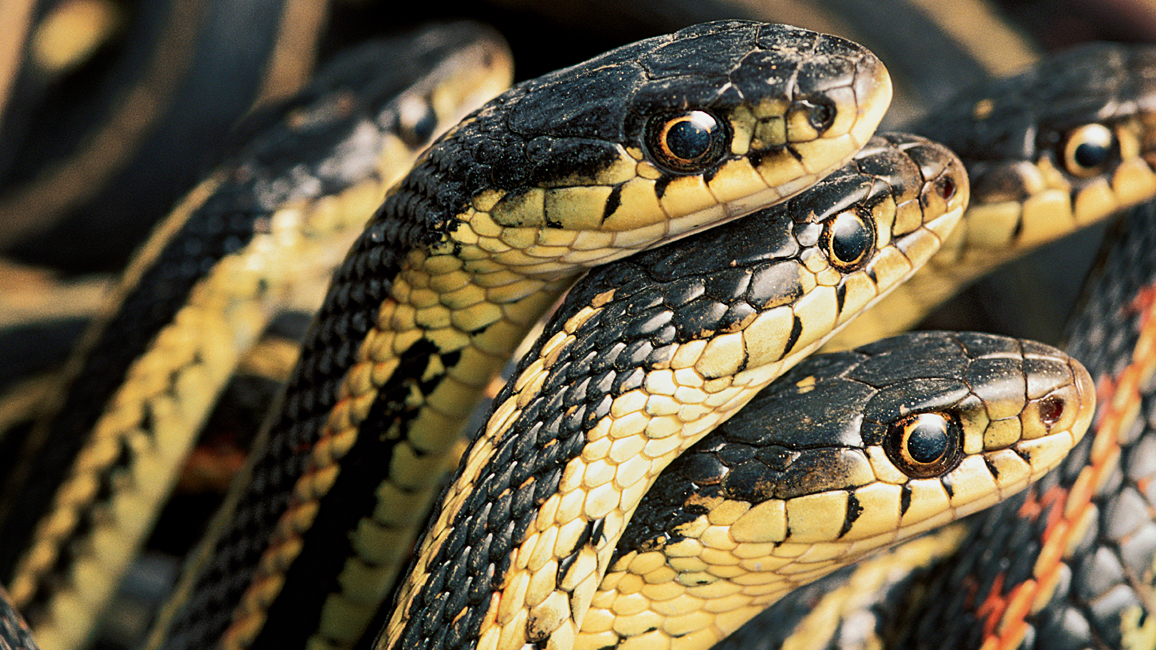
Gobs O’ Garters
By Ellen Lambeth; photos by Nic BishopWinter’s chill has passed. The Canadian sun shines stronger. The ground grows warmer. And everything’s coming up . . . snakes?
Yep, it’s true. Every year about this time, an amazing thing happens (see photo above): Red-sided garter snakes begin crawling out of their winter dens by the thousands—many, MANY thousands!
Common garter snakes can be found almost anywhere in North America, except deserts. Some people even mistakenly call them “garden (or gardener) snakes.” The red-sided garters live throughout the central part of the continent. But nowhere do they gather in such huge numbers as they do here at the Narcisse Snake Dens in Manitoba, Canada (see map above).
SLEEP TIGHT
Like all snakes, red-sided garters try to avoid freezing temperatures. They prefer safe places that don’t freeze, such as a hibernaculum that’s deep enough underground. The limestone dens in this part of Canada are just the thing. Some of these dens are big enough for hundreds of snakes. And a few can hold up to 75,000 or more!
Each fall, garters come from miles around to these dens. They then creep inside and huddle together. As outside temperatures drop, the snakes also cool down and become inactive. They don’t even have to eat. They just stay put through the winter.
RISE & SHINE!
Once the ground gets warmer with the coming spring, the snakes slowly warm up and begin to stir. Their hearts beat faster, and their breath quickens. The males are first to leave the dens. By now, they may not have eaten for eight months! But they’re not looking for food—not yet. They’re waiting for the females to come out.
When a female finally emerges, males make a beeline for her. How? They follow her scent! Her body gives off a pheromone that tells the males she’s ready to mate. Sometimes, a female has so many suitors that they swarm over her in what’s called a “mating ball.”
MAKING DISCOVERIES
So many snakes in one place might seem like a nightmare to someone who’s afraid of them. But to a herpetologist, it’s a dream come true—a great opportunity for study!
One task is to just figure out how many snakes are in the dens. It’s like trying to guess how many beans are in a jar without having to count them one by one. Some of the snakes are collected and measured. Some are marked with numbers, and tiny radio transmitters are put inside them. Then scientists use special equipment to track where they go after they’re released.
We know that the snakes mate after leaving the dens and that the females give birth (garters don’t lay eggs). And we know they all go their separate ways to spend the summer in nearby wetlands, feasting on frogs and other small creatures. But how do they find their way back to the dens the next fall? And where do the baby snakes spend their first winter, since they don’t use the dens?
Scientists are still working on these and other mysteries. Good thing gobs of garters will be wiggling out of their dens again this time next year!
“Gobs O’ Garters” originally appeared in the April 2015 issue of Ranger Rick magazine.
(Click on each image above for a closer view of the story.)



















